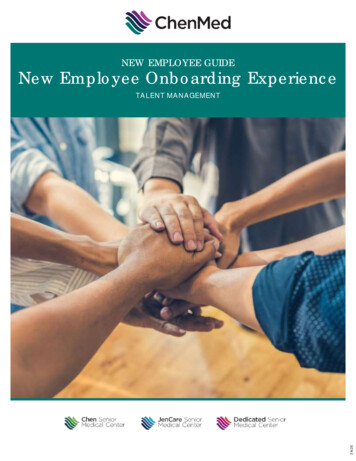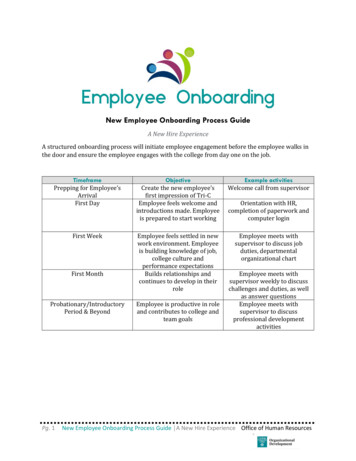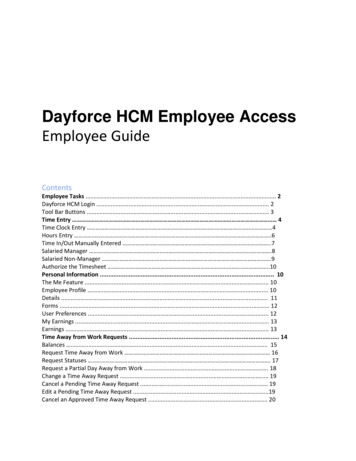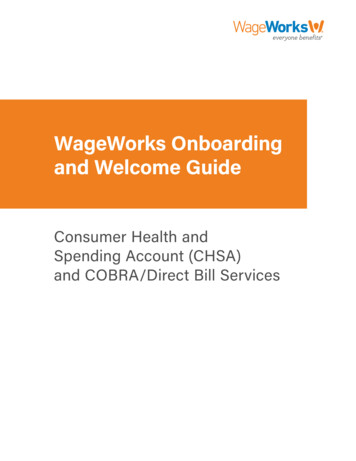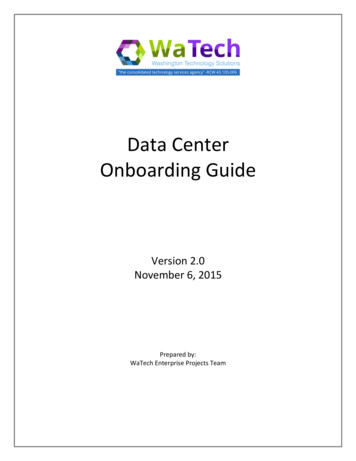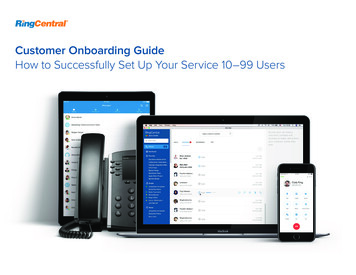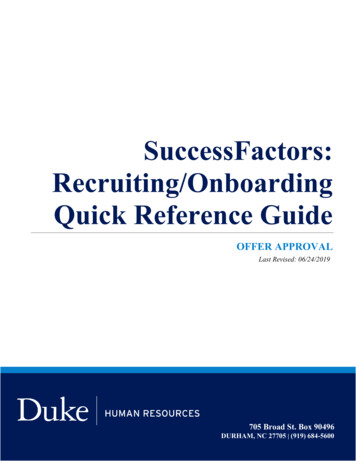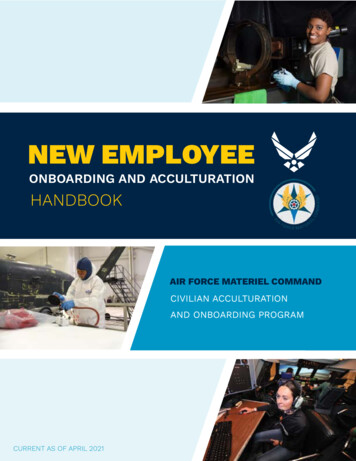
Transcription
NEW EMPLOYEEONBOARDING AND ACCULTURATIONHANDBOOKAIR FORCE MATERIEL COMMANDCIVILIAN ACCULTURATIONAND ONBOARDING PROGRAMCURRENT AS OF APRIL 2021
iiiiiWELCOME TO AFMC!OUR CIVILIANS: CRITICAL MEMBERSYOU ARE PART OF THE FAMILYthe Constitution of the United States. Civilians make up over 80% of AFMC’s 87 thousandCongratulations on your new position at Air Force Materiel Command! Thank you for yourcommitment to our nation and willingness to serve in this new capacity. We are excited toAll Airmen, both civilian and military, take an oath pledging to solemnly defend and supportAirmen, daily serving among our nation’s military members. As a civilian, you are critical toour ability to execute the mission each and every day.welcome you to the AFMC family.View AFMC/CC, General Bunch’s Welcome to new AFMC AirmenOUR MISSIONWatch the former CSAF & CMSAF speak about the value of Civilian AirmenOUR LEADERSHIPAir Force Materiel Command is commanded by General Arnold W. Bunch. Serving beside himare Lieutenant General Carl E. Schaefer, Deputy Commander; Patricia M. Young, Executive“Powering the world’sDirector; and Chief Master Sergeant Stanley C. Cadell, Command Chief Master Sergeant.greatest Air Force, weThese AFMC Senior Leaders are headquartered at Wright-Patterson Air Force Base, Ohio.develop, we deliver, wesupport, and we sustainwar-winning capabilities.”Learn more about the AFMC MissionRead Gen ArnoldRead Lt Gen CarlRead Mrs. PatriciaRead CMSgtBunch’s bioSchaefer’s bioYoung’s bioStanley Cadell’s bio
ivTHANK YOU FOR JOINING THE TEAMWe hope that this guide will help you navigate your first days with AFMC. Please take this timeto become familiar with your new command, leadership, and the resources available to you.We look forward to working for and with you in the coming days. Welcome to AFMC!vWe are excited to have you on the Air ForceMateriel Command Team!As a civilian Airman, you are important to the Air Force, AFMC, and the mission.This guide will serve as a reference tool as you transition into your Air Force career.It explains what to expect during the In-Processing, Onboarding, and Acculturation processes,and provides helpful information and links to acquaint you with the expectations, traditions,and culture of the Federal Civil Service, the United States Air Force, and Air ForceMateriel Command.HOW TO USE THIS GUIDE*If links in the guide do not open, please copy and paste the link into your web browser.We are excited to have you as a member of the AFMC team, and want you to have a smoothtransition and great start as you begin your Air Force career. This guide is a way to supportyou over the days, weeks, and months in your job to help you become fully integrated into theAir Force culture.As part of this guide, you will find the following:Employee Onboarding and Acculturation Process Overview and ChecklistWe have created a helpful checklist to guide you through your first days as a new hire.The checklist provides an overview of the activities that need to be planned and accomplishedprior to your first day of employment, as well as during the first week, month, quarter, 180days, and through your two-year probationary period.Human Resources Policies and ProceduresThis section will discuss pay, leave, and other Human Resources topics and is designed to be ahelpful tool and reference.Benefits and EntitlementsThis section highlights information about benefits and entitlements available toAir Force civilians.
viOperations Security, Key Administrative and Computer Use Policies and ProceduresIn this section, you can find an introduction to important security, administration, andcomputer systems policies and usage.Air Force Customs, Courtesies, Traditions, Symbols, and LingoThe Air Force is rich in tradition and instills pride in its members because of the history,mission, capabilities, and the respect it has earned in the service of the United States.This section introduces you to protocol to be followed throughout your career.Information Resources and Common AcronymsThis section contains a list of websites where to find valuable information on topics helpfulin your day-to-day operations. It also includes a listing of acronyms commonly used by theAir Force.WHAT IS NEW EMPLOYEE ACCULTURATION?WHY IS IT IMPORTANT?Acculturation is the process of integrating and familiarizing new employees to the Air Forceand their unit – preparing them for their future career and familiarizing them with itsmission, vision, and core values. It is most importantly, a socialization process that supportsnew employees by helping them learn, adjust to, internalize, and ultimately embody theorganizational culture.AFMC’s leadership wants you to feel welcome, comfortable, prepared, and supported; tohasten the time to make an impact and be productive in your new position; and to facilitateyour success for years to come.TABLE OF CONTENTSTHE OATH OF OFFICE2THE UNITED STATES AIR FORCE: AN OVERVIEW4AIR FORCE MATERIEL COMMAND: OUR HERITAGE10AFMC CENTER BREAKDOWN12USAF CONNECT APP18NEW EMPLOYEE CHECKLISTS19AIR FORCE EMPLOYEE ASSISTANCE PROGRAM23MENTORSHIP AND TRAINING25HUMAN RESOURCES POLICIES AND PROCEDURES28PHYSICAL AND COMPUTER ACCESS: COMMON ACCESS CARD48BENEFITS AND ENTITLEMENTS52KEY ADMINISTRATIVE AND COMPUTER USE POLICIES AND PROCEDURES66CUSTOMS, COURTESIES, TRADITIONS, SYMBOLS, AND LINGO72AIR FORCE ACRONYMS81HELPFUL LINKS97
2THE OATH OF OFFICEWHY DO WE SWEAR THE OATH?As federal civil servants, we take an oath3THE OATH“I do solemnly swear that I will support and defend theof office by which we swear to support andConstitution of the United States against all enemies, foreigndefend the Constitution of the United States ofand domestic; that I will bear true faith and allegiance to theAmerica. The Constitution not only establishesour system of government, it actually definesthe work role for federal employees-- “toestablish Justice, insure domestic Tranquility,provide for the common defense, promote thegeneral Welfare, and secure the Blessings ofsame; that I take this obligation freely, without any mentalreservation or purpose of evasion; and that I will well andfaithfully discharge the duties of the office on which I am aboutto enter. So help me God.”Liberty”HISTORYThe history of the oath for federal employees can be traced to the Constitution, whereArticle II includes the specific oath the president takes – to “preserve, protect, and defendthe Constitution of the United States.” Article VI requires an oath by all other governmentofficials from all three branches, the military, and the states. It simply states that they “shallbe bound by oath or affirmation to support the Constitution.” The very first law passed byPREPARING TO TAKE THE OATHUnderstanding the content and coverage of theConstitution and its amendments, including the Billof Rights, is good preparation for taking the Oath ofOffice. Review them through the links below:the very first congress implemented Article VI by setting out this simple oath in law. “I dosolemnly swear or affirm (as the case may be) that I will support the Constitution of theConstitutionUnited States.”SIGNIFICANCEThe wording we use today as Executive Branch employees is now set out in Chapter 33 ofTitle 5, United States Code. The wording dates to the Civil War and what was called theIronclad Test Oath. Starting in 1862, Congress required a two-part oath. The first part,referred to as a “background check,” affirmed that you were not supporting and had notsupported the Confederacy. The second part addressed future performance, that is, whatyou would swear to do in the future. It established a clear, publicly sworn accountability.In 1873, Congress dropped the first part of the Ironclad Test Oath, and in 1884 adopted thewording we use today.Amendments
4THE UNITED STATES AIR FORCE:AN OVERVIEW51903-1911: Into the Air They GoThe dawn of the new century witnessed man take to the air for the first time in a heavierthan-air-powered aircraft conceived and flown by two Ohio bicycle salesmen. Theirmaiden flight on that cold, windy December day in 1903, and the subsequent decadeof innovation that followed, would help put the U.S. on a course to become the mostpowerful, most advanced country in the world.“The mission of the United States Air Force is to fly, fight, andwin in air, space and cyberspace. Our rich history and our visionguide our Airmen as we pursue our mission with excellence andintegrity to become leaders, innovators, and warriors.”FLYING ON A VISIONAIR FORCE VISIONThe U.S. Air Force is the world’s preeminent force in air, space, and cyberspace. We maintainthat distinction by maintaining our objective of global vigilance, reach, and power andremaining true to our vision statement: The World’s Greatest Air Force—Powered by Airmen,1912-1939: WWI and the New FrontierFueled by Innovation. Through shared values, key capabilities, and upholding our Airman’sFor centuries, war was reserved for the battlefields and the high seas. But when the war toCreed, we continue to achieve our mission and aim high in all we do.end all wars broke out in Europe on July 28, 1914, the once-peaceful skies would quicklyknow the ravages of manned conflict. Soon, fixed-wing aircraft would be conductingUSAF HISTORY OVERVIEWFor over a century, the U.S. Air Force has defended this country in the air, space, andcyberspace through the skill and the bravery of American Airmen.ground attacks and taking part in aerial dogfights with the U.S. poised to take the lead.
671940-1945: WWII and the Battle for the Skies1950-1953: The Korean WarThe Second World War would draw over 30 countries and all the world’s superpowersWhen war broke out between North and South Korea, the United States once againinto the deadliest conflict in human history, and there was no battleground more vital tofound itself thrust into an international conflict thousands of miles from home. Backedvictory than the sky above. Beginning with Japan bombing Pearl Harbor on December 7,by China and the Soviet Union, North Korea was on the brink of victory when America1941, and ending with the U.S. dropping two atomic bombs on Japanese cities almost fourentered the fray and turned the tide. The war ultimately ended in a stalemate, but the U.S.years later, the skies became the ultimate high ground.reconfirmed its role as a global military power.1946-1949: Pushing the Envelope1954-1964: Chasing the Ultimate HorizonIt was a time of relative peace, but not an idle time. The lessons learned during theThe decade that separated the Korean and Vietnam wars bore witness to manyglobal conflict of WWII propelled the U.S. to push the envelope of what was possible bothtechnologically and organizationally, including the separation of the Air Force into its ownbranch of the military. In the process, the U.S. became a leading superpower.achievements of the human spirit. Suddenly the skies were no longer high enough, as manbegan reaching for the stars. Airmen continued to test the boundaries of the human bodyby flying faster and higher and longer than anyone had ever traveled before.
81965-1973: The War in VietnamThe battle to halt the spread of communism drew the U.S. back to Southeast Asiaonce more and into a conflict unlike any other. Over the course of the campaign, theimportance of air superiority and the use of new tactics and more sophisticated weaponssystems would forever change the way wars are fought.91990-1999: Modern Air SuperiorityAs the 20th century came to a close, the U.S. cemented its role as the most advancedAir Force in the world with its display of air power during the liberation of Kuwait, theactivation of the GPS system, and the launching of the first unmanned aerial vehicle,which would once again change the way battles are fought from the skies.1974-1989: The Tide of Change2000-Present: 21st Century and BeyondAfter nearly a decade of fighting an unpopular war overseas, the Air Force experienced anShortly after the world celebrated the birth of a new century, the U.S. would be plungedera of relative peace that saw new breakthroughs in technology and service. In the yearsinto its longest war ever after it was attacked on September 11, 2001. The war on terrorthat followed the Vietnam War, the many contributions by women and minorities in the Airwould be an ongoing conflict against an enemy without traditional borders and see theForce were being recognized and new opportunities were being opened.emergence of unmanned aerial vehicles as a dominant player in the Air Force’s air attack.
10AIR FORCE MATERIEL COMMAND:OUR HERITAGE11GAINING ALTITUDEWith the creation of the Air Force, anotherchange occurred with the creation of the AirTAKING OFFResearch and Development Command (ARDC)Air Force Materiel Command (AFMC) traces its heritage back to 1917. The command’s earliestitself strictly to research and development.antecedent is the Airplane Engineering Division located about two miles west of today’sAir Materiel Command remained; however, itWright-Patterson, AFB’s (WPAFB), Area B, at McCook Field. McCook Field started as a Worldwas redesignated on 1 April 1961 as Air ForceWar I-era experimental engineering facility in Dayton, Ohio. Later in 1918, the Fairfield AviationLogistics Command (AFLC). On the same date,General Supply Depot was organized at Wilbur Field (now a part of Area A at WPAFB). TheARDC gained the added responsibility of weaponAirplane Engineering division and Fairfield Aviation General Supply Depot combined in 1926system acquisition, and was redesignated Airforming the Air Corps Materiel Division. This Division, the largest branch of the Air Corps,Force Systems Command (AFSC).on 23 January 1950. This command dedicatedmaintained responsibility for all aircraft and equipment research, development, procurement,maintenance, supply, and flight test.The ADM-20 Quail missile, here undergoing repair atOklahoma City, 1962, was to serve as a decoy to confuseenemy radar tracking US bombers
establish Justice, insure domestic Tranquility, provide for the common defense, promote the general Welfare, and secure the Blessings of Liberty” The wording we use today as Executive Branch employees is now set out in Chapter 33 of Title 5, United States Code. The wording dates to the Civil War and what was called the Ironclad Test Oath .
